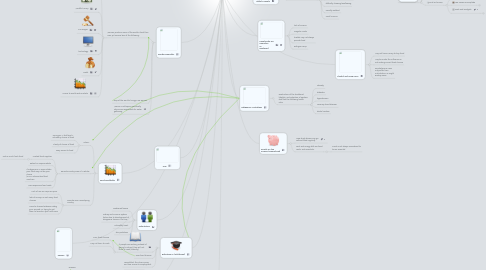
1. Malnutrition
1.1. weakened bones
1.2. Kidney and immune system failure due to development of dangerous toxins in the liver
1.3. Unhealthy heart
1.4. Skin problems
2. Gender inequality
2.1. Women produce more of the world's food than men yet receive less of the following:
2.1.1. Education
2.1.2. Wealth/Money
2.1.3. Fair wages
2.1.4. technology
2.1.5. credit
2.1.6. Access to world wide markets
2.2. 60% of the world's hungry, are women.
2.3. Women in Ethiopia, specifically Likimsi are responsible for water gathering
3. Hunger
3.1. 1 in 7 people on the planet go hungry
3.2. People who are chronically hungry, are undernourished
3.2.1. As a result they are weak
3.2.2. tired
3.2.3. poor concentration
3.2.4. difficult to work
3.2.5. difficult to study
3.3. Problems in the countryside (where most of the hungry are)
3.3.1. Solution: Boost the rural economy
4. War
5. Famine
6. Water
6.1. Lack of access to constant and safe water
6.1.1. Disease
6.1.2. Less ability to grow crops/food
6.1.3. Factories close
6.1.4. Crop yields decline
6.1.5. sick workers = unproductive
6.1.6. Fisheries might be destroyed
7. Education or lack thereof
7.1. If people are working instead of going to school, they will not learn to read (illiteracy)
7.1.1. Poor food choices
7.1.2. May not learn to cook
7.2. Poor food choices
7.3. Less skilled, thus less money and less access to employment
8. Food availability
8.1. Urban:
8.1.1. Time poor = fast food = unhealthy choice of food
8.1.2. Plenty of choice of food
8.1.3. Easy access to food
8.2. Remote country area of Australia
8.2.1. Limited food supplies
8.2.1.1. Not as much fresh food
8.2.2. Reliant on supermarkets
8.2.3. If indigenous, in some states your food may not be your choice (ie NT. Intervention/food vouchers
8.2.4. More expensive food costs
8.3. Remote area, Developing country
8.3.1. Lack of rain so crops are poor
8.3.2. lack of money, so not many food choices
8.3.3. Have to choose between eating your animals, or trying to get them to breed so you have more
9. Globalisation
10. Natural Disasters
11. Get started!
11.1. Use toolbar to add ideas
11.2. Key shortcuts
11.2.1. INS to insert (Windows)
11.2.2. TAB to insert (Mac OS)
11.2.3. ENTER to add siblings
11.2.4. DEL to delete
11.2.5. Press F1 to see all key shortcuts
11.3. Drag & Drop and double-click canvas
11.4. Find out more?
11.4.1. Online Help
11.4.2. Use Cases & Templates
11.4.2.1. Personal Todo List
11.4.2.2. Vacation Planning
11.4.2.3. Meeting Minutes
11.4.2.4. Project Plan
11.4.2.5. more...
11.4.3. Tools and Gadgets
11.4.3.1. Offline Mode
11.4.3.2. Geistesblitz Tools
11.4.3.3. Email & SMS Gateways
11.4.3.4. Offline Mode
12. People with disabilities
12.1. Depending on circumstance may have less:
12.1.1. Education
12.1.2. choice of food
12.2. May not be mobile
12.2.1. Less access to fresh food
12.2.2. May have to rely on others to bring in food
13. Alcohol and Drug users
13.1. May not have Money to buy food
13.2. May be under the influence so not making correct food choices
13.3. amphetamine users may suffer from malnutrition, as might Ecstasy users
14. Elderly people
14.1. May not be mobile
14.1.1. Less access to food
14.1.2. May rely on Meals on Wheels
14.2. At further risk of poor food equity if they suffer from the following:
14.2.1. Parkinson's Disease
14.2.2. Alzheimer's Disease
14.2.3. after effects of a stroke
14.2.4. housebound due to a bone/hip fracture
14.2.5. difficulty chewing/swallowing
14.2.6. socially isolated
14.2.7. Small income
15. Indigenous Australians
15.1. Destruction of the traditional lifestyle, and adoption of western diet had the following health risks:
15.1.1. Obesity
15.1.2. diabetes
15.1.3. hypertension
15.1.4. coronary heart disease
15.1.5. dental cavities
16. People on low income/Unemployed
16.1. New study shows may go without food regularly
16.2. Rent and energy bills are fixed costs, and essentials.
16.2.1. Food is not always considered to be an essential
